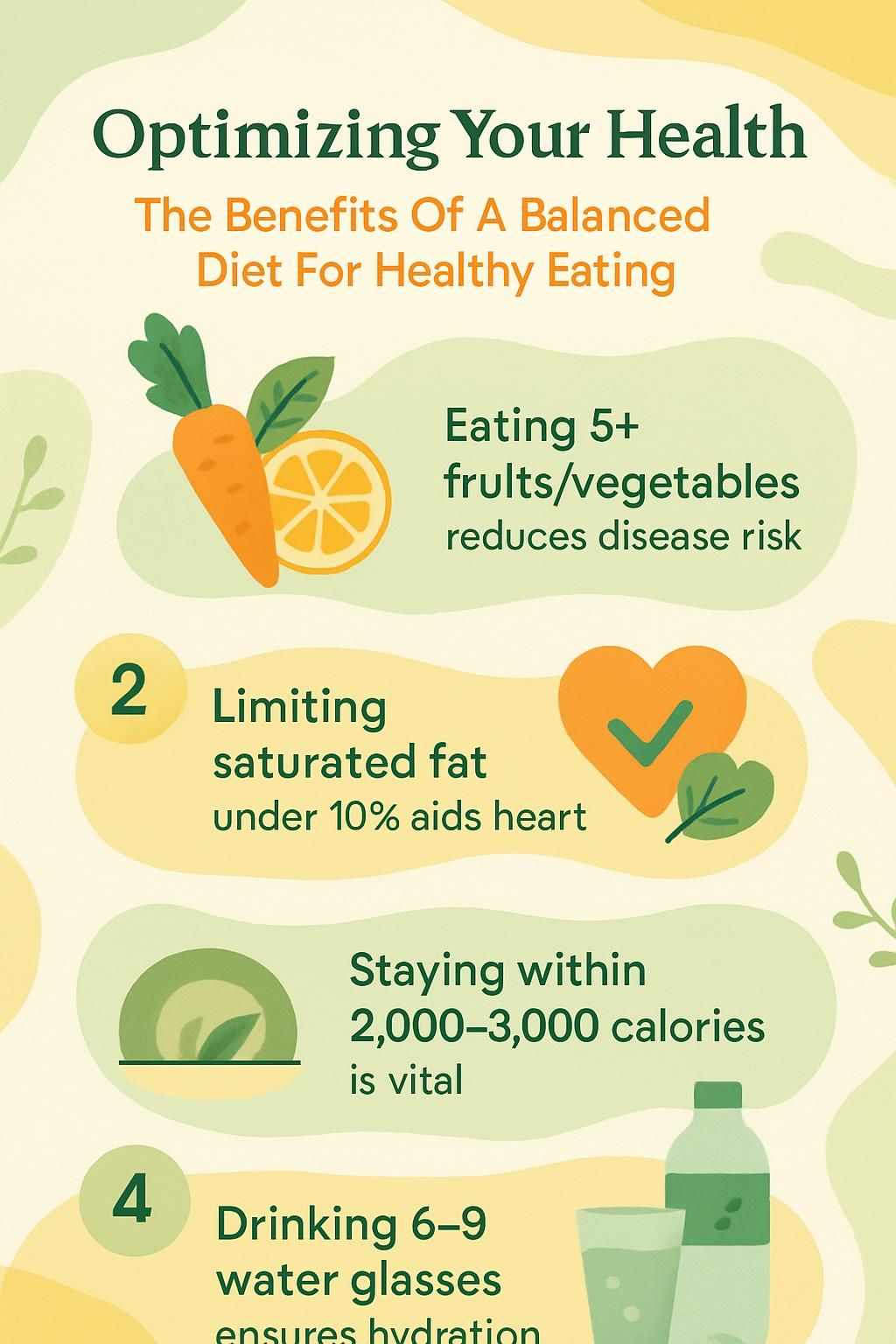Optimizing Your Health: The Benefits Of A Balanced Diet For Healthy Eating
Our Nutrition Assistant AI Suite will transform your body. You will lose fat, get toned, and build muscle. Gain confidence and optimal health.
Healthy eating can feel confusing. I used to wonder what a balanced diet really looked like in daily life. It turned out simpler than I thought. Eating a variety of foods in the right amounts helps me keep a healthy weight and lowers my risk of heart disease and diabetes.
In this guide, I break down the parts of a balanced diet, explain how it supports both body and mind, and share practical steps you can use today. Small changes add up fast.
Key Takeaways
- Eating at least 5 portions of fruits and vegetables each day is linked with lower risk of heart disease, stroke, some cancers, and lower all-cause mortality of up to 42 percent in large studies.
- Balanced meals built around whole grains, lean proteins, healthy fats like olive oil or fish oils, and low-fat dairy support weight control and reduce chronic disease risk.
- Keep saturated fat under 10 percent of calories and avoid trans fats to protect heart health. Processed foods high in added sugar or salt raise risks for obesity and high blood pressure.
- Portion control matters. Visual models like MyPlate or the Healthy Eating Plate help adults stay within about 2,000 to 3,000 calories, depending on activity.
- Hydration supports every organ. Aim for 6 to 8 glasses of water daily; water-rich foods like watermelon and cucumbers also help.

What is a Balanced Diet?

A balanced diet includes a variety of healthy foods from all major food groups. Getting the right mix gives me the nutrients needed for energy, growth, and long-term health.
What does a balanced diet include?
Eating a balanced diet supports healthy eating and helps me maintain a healthy weight. I try to include all major food groups each day.
- Have at least 5 portions of different fruits and vegetables daily as part of the 5 A Day goal.
- Base most meals on starchy foods such as potatoes, bread, rice, or pasta, choosing whole grains for extra fiber.
- Include dairy or fortified dairy alternatives like soy beverages for calcium and other key nutrients.
- Choose beans, peas, lentils, fish, eggs, and lean meats for protein that builds and repairs muscle.
- Use small amounts of unsaturated oils and spreads. Olive oil or canola oil supplies helpful fatty acids while limiting saturated fat.
- Limit salty snacks, sugary drinks, desserts with added sugar, processed meats like bacon, and foods with trans fats. They are often high in calories and low in nutrients.
- Drink 6 to 8 glasses of water or unsweetened fluids daily to stay hydrated without extra calories from soft drinks.
- Choose a variety of foods across the week to cover vitamins and minerals needed for normal body function.
- Watch portion sizes so you do not eat more calories than you need. Check food labels when you can.
- Plan balanced meals that include all five main food groups, fruits and vegetables, starchy carbohydrates, protein foods, dairy or alternatives, and healthy oils.
Which nutrients are essential in a balanced diet?
A balanced diet supplies the building blocks for energy, growth, and repair. Each nutrient plays a different role, together they support every system.
- Carbohydrates provide energy. Whole grains like brown rice, oats, and whole wheat also supply fiber for a healthy gut.
- Proteins repair tissues and support muscle health. I often choose fish, poultry, eggs, legumes like peas and lentils, and a small handful of nuts or seeds.
- Healthy fats protect cells and support the heart. Unsaturated fats from vegetable oils and omega-3 fats from fish can lower LDL cholesterol.
- Vitamins support many functions. For example, vitamin B12 helps nerves and is found in dairy foods and fortified alternatives.
- Minerals matter too. Calcium strengthens bones and teeth. Dairy and calcium-fortified plant drinks are useful sources.
- Antioxidants, found in fruits and vegetables, help defend against chronic conditions like type 2 diabetes and heart disease.
- Water regulates body temperature, blood pressure, and organ function. I keep water nearby to sip through the day.
- Dietary fiber aids digestion and supports weight goals. Whole grains, beans, peas, and fruits like apples are easy ways to get more.
Getting enough of each nutrient supports daily activity and lowers long-term disease risk through steady, healthy choices.
Why Is a Balanced Diet Important?
A balanced diet keeps me active and supports daily goals. The right foods and drinks work together to build a healthy eating pattern.
How does a balanced diet support overall health?
Eating a variety of fruits and vegetables gives my body vitamins, minerals, and antioxidants. Many healthy plate guides suggest these foods fill about half the plate.
Keeping foods high in saturated fat, added sugars, and salt to a minimum lowers the risk of heart disease, obesity, high blood pressure, stroke, diabetes, and some cancers. Choosing whole grains over refined grains supports digestion and helps me feel full longer.
These habits also support the immune system, so I tend to get sick less often during cold season.
Picking real food over processed snacks gives my body what it needs to perform well.
Learning which nutrients matter most helped me build a smarter grocery list each week.
Can a balanced diet reduce chronic disease risk?
Yes. Eating at least 5 portions of fruits and vegetables daily is linked with lower chances of heart disease, stroke, and some cancers. Research using the Alternate Healthy Eating Index from Harvard found that people with top scores had large drops in cardiovascular risk, about 30 to 40 percent.
In long studies, including one that followed thousands of British civil servants for 18 years, higher scores were linked with fewer deaths from all causes and a 42 percent drop in deaths from heart disease.
Processed meats raise cancer risk. Too much salt raises blood pressure, which increases heart attack and stroke risk. Replacing refined grains with whole grains, choosing lean proteins, and using healthy fats instead of butter can improve health over time.
Next, here is how a balanced diet supports weight control.
How does a balanced diet help with weight management?
Eating from all food groups helps me lose weight in a steady way and maintain it. Many people get too many calories from items like cakes, soda, pizza, and chips. These foods are heavy in added sugar or saturated fat, and they offer few nutrients.
Portion control is key. Swapping sugary drinks for water or plain coffee or tea trims calories fast. Picking whole grains, lean proteins, nuts and seeds, and plenty of fruits and vegetables keeps me full with fewer calories.
MyPlate helps me size portions. Support from a healthcare team or a dietitian can guide anyone who needs to lose weight. Exercise pairs well with good nutrition to support a healthy circulatory system.
Key Food Groups in a Balanced Diet
A balanced diet means I eat different foods from core groups every day. Knowing each group makes planning easier.
Why are fruits and vegetables important?
Fruits and vegetables should make up a large share of a healthy diet. The goal is at least five portions a day, about 400 grams total. A variety of colors helps me cover a wider set of nutrients.
- One portion equals 80 grams fresh, frozen, or canned; 30 grams dried fruit, best with meals; or 150 milliliters of juice or smoothies. Limit juice to one portion per day due to sugar.
Regular intake lowers the risk of heart disease, stroke, and some cancers. They also supply vitamins, fiber, and potassium, which supports heart and gut health. At home, I add chopped vegetables to eggs, pasta, and stir-fries, and I keep fruit on my desk for easy snacking.
If you have diabetes, check portion sizes with a registered dietitian since some fruits can raise blood glucose when eaten in large amounts.
What role do whole grains play?
Whole grains like brown rice, whole wheat bread, and oats are essential sources of energy and fiber. Many healthy plate models suggest grains should fill about a quarter of the plate, with whole grains favored over refined grains.
Whole grains keep their fiber, vitamins, and minerals during processing. Switching from white flour to whole wheat improves B vitamin and fiber intake. Eating more whole grains helps my cholesterol profile and heart health. Potatoes with skins count as a fiber source too.
Meals with quinoa or wild rice keep me full longer than meals with refined grains. Adding a simple grilled protein to whole grains delivers steady energy without sharp blood sugar spikes.
How do lean proteins benefit health?
Lean proteins help the body grow and repair. Skinless poultry, fish, eggs, beans, lentils, and nuts or seeds provide minerals and vitamins for strong muscles. Eating oily fish like salmon or sardines twice a week gives me vitamin B12 and omega-3 fats that protect the heart.
Plant proteins such as beans or tofu are lower in saturated fat and add fiber. Limiting processed and red meats lowers certain cancer risks. Cooking methods matter. I often roast chicken or grill fish instead of frying to keep calories lower while preserving nutrients.
What are healthy fats and why do they matter?
I pay attention to fat quality at each meal. Healthy fats in extra virgin olive oil, avocados, fatty fish, and unsaturated vegetable oils support cells and provide lasting energy.
Type matters more than total. Keep saturated fat under 10 percent of daily calories and avoid trans fats found in some processed foods. Use butter and cream sparingly. Keep deep-fried foods rare since they add calories and unhealthy fats.
Adding good fats helps the body absorb vitamins A, D, E, and K. A small handful of nuts or seeds makes a satisfying snack when afternoon cravings hit.
What are good dairy or dairy alternatives?
Milk, yogurt, and cheese supply protein and calcium for bone strength. Lower fat and lower sugar options help me limit saturated fat while still covering nutrients.
Unsweetened, calcium-fortified soy drinks count as dairy alternatives. Many plant milks, like almond, soy, oat, or coconut, are fortified with vitamin D and minerals. Check labels for added sugar. One to two servings of dairy or alternatives per day fits most healthy plate models.
How Does a Balanced Diet Benefit Physical Health?
A balanced diet gives my body the fuel and nutrients it needs to function well. It helps me stay active, alert, and strong.
How does it improve energy levels?
Carbohydrates, especially higher fiber ones, are my main fuel. Whole grains, fruits, vegetables, and lean proteins prevent energy crashes since they avoid empty calories and excess sugar.
Healthy fats provide steady energy and support metabolism. Many adults do well around 2,000 calories per day, though needs vary. Active adults may need 2,000 to 3,000 calories, while sedentary adults may need less. Choosing nutrient-dense foods helps me fight fatigue through the day.
Can it strengthen the immune system?
Yes. A balanced diet provides vitamins and minerals that support immune cells. Vitamin D, zinc, and vitamin C are important. After I added more fruits and vegetables, I noticed fewer colds in winter.
Whole grains and lean proteins support tissue repair. Limiting processed foods and added sugars helps lower chronic inflammation, which supports immune function. Dairy or fortified alternatives can supply extra vitamin D when sunlight is limited.
How does it maintain healthy organ function?
Nutritious meals support the heart, liver, kidneys, and brain. Limiting saturated fats and salt helps protect the heart and blood vessels. Lean proteins support repair and maintenance of organ tissues.
Whole grains add fiber for gut health. Dairy or fortified alternatives provide calcium and vitamin D for bones and teeth. Drinking enough water supports kidney function and helps the body move nutrients where they are needed.
What is its role in muscle and bone health?
Dairy foods and fortified alternatives supply calcium and protein, both vital for bones. I choose lower fat options to limit saturated fat. Lean proteins in fish, eggs, beans, and lentils support muscle growth and repair.
Whole grains add key micronutrients. Soy products and beans are excellent plant proteins. Vitamin D helps the body absorb calcium, which strengthens bones. Keeping processed meats low supports both muscle and bone health over time.
How Does a Balanced Diet Benefit Mental Health?
A balanced diet supports a healthy mind. Vitamins, minerals, fiber, and healthy fats help keep energy and focus steady.
Can it enhance mood and reduce stress?
Foods rich in magnesium, like leafy greens and nuts, help me handle stress. Diets high in fruits, vegetables, and whole grains are linked with more stable moods.
After I cut back on added sugars and processed snacks, my mood felt steadier. Staying hydrated also supports emotional balance. Omega-3 fats from fish or walnuts have been linked with fewer depression symptoms in several studies.
How does it boost cognitive function?
Good nutrition supports memory and learning. I notice better focus when I include iron-rich greens and whole grains. B vitamins from grains and lean proteins help maintain healthy brain pathways that support clear thinking.
Whole grains provide a slow, steady energy release, which helps avoid afternoon slumps. Diets rich in fruits and vegetables are linked with healthier aging of the brain. Limiting empty calories improves concentration, and dark leafy greens supply folate and magnesium for cognitive support.
Does it lower the risk of depression and anxiety?
Healthy eating patterns are associated with lower risk of depression and anxiety in observational research. Diets high in processed foods and added sugars raise risk.
Omega-3 fats from fish and some seeds are linked with better mood. Whole grains help stabilize blood sugar, which supports stable mood. Healthy plate models guide me toward choices that also support mental well-being.
How Can I Adopt a Balanced Diet?
I started with small steps and built from there. A balanced diet with enough vitamins and minerals made my energy steadier within weeks.
What small changes can I start with?
Simple switches add up quickly. I focused on daily habits that helped most.
- Add fruit to breakfast cereal or yogurt, or pack a banana or apple for a snack.
- Swap white bread, pasta, or rice for whole grain versions to add fiber, iron, and magnesium.
- Add one extra serving of vegetables at lunch or dinner. A side salad or steamed broccoli works well.
- Choose lean meats and skinless poultry to reduce saturated fat and support heart health.
- Replace sugary drinks with water, unsweetened tea, or black coffee to cut calories.
- Reduce the portion size of fries, chips, or desserts. Enjoy them less often and in smaller amounts.
- Limit processed and ready-to-eat foods. Cooking simple meals at home helps me control ingredients and portions.
How important is portion control?
Portion control prevents overeating and helps me keep a healthy body weight. One medium fruit or three heaping tablespoons of vegetables, about 80 grams, counts as one portion of produce.
Many plate models suggest half the plate fruits and vegetables, about a quarter grains, and just under a quarter protein foods. Keeping calorie-dense treats small and focusing on nutrient-rich foods keeps energy intake balanced.
Calorie needs vary by age, size, and activity. Visual guides like the Eatwell or MyPlate models make portions easier to see and repeat.
Why avoid processed and sugary foods?
Processed and sugary foods often pack many calories without many nutrients. When I ate lots of cakes, soda, and chips, I felt hungry again soon after.
High intake of processed meats is linked with higher cancer risk. Too much sugar can lead to weight gain and dental problems. Excess salt in packaged snacks can raise blood pressure.
Swapping frozen pizza for a homemade version on whole wheat crust with vegetables improved my energy. Picking nutrient-dense foods from each food group supports better health in the long term.
How do I incorporate a variety of food groups?
Getting a mix of food groups keeps my diet complete and more enjoyable. These habits make it simple.
- Include at least five portions of varied fruits and vegetables daily. Aim for many colors.
- Base meals on higher fiber starchy foods like whole grains or potatoes with the skin for better digestion.
- Use protein foods like beans, lentils, fish, eggs, or lean meats to build muscle and steady energy.
- Add small amounts of unsaturated oils like olive oil instead of butter for healthier fats.
- Choose dairy or calcium-fortified alternatives like unsweetened soy drinks to support bone health.
- Buy local and seasonal produce when possible. It often tastes fresher and may hold more nutrients.
- Cook more at home to control ingredients and portions and to keep sodium and added sugars lower.
The Role of Hydration in a Balanced Diet
Water is the quiet partner of good nutrition. It helps the body use the food you eat.
Why is water important for the body?
Water supports metabolism, temperature control, and waste removal. Experts often suggest 6 to 8 glasses of fluids a day. Hydration improves digestion and helps nutrients move throughout the body.
Without enough water, I feel tired and find it hard to focus. My skin gets dry and my workouts feel harder. Consistent hydration supports better energy, mental function, and organ health.
What are effective tips for staying hydrated?
I keep my fluid intake steady with simple habits.
- I carry a refillable bottle and sip often during the day.
- I choose water over soda or energy drinks to cut sugar while staying hydrated.
- I drink before, during, and after workouts to replace fluids quickly.
- I set reminders on busy days or in hot weather so I do not forget to drink.
- I eat hydrating foods, especially watermelon, cucumbers, and oranges.
- I limit fruit juice to one small glass per day to avoid extra sugar.
- I drink a glass of water with each meal to meet daily goals and support digestion.
Which foods help with hydration?
Foods can provide fluids too. I add these to meals and snacks to boost hydration.
- Water-rich fruits like watermelon, oranges, and strawberries contribute a lot of fluid.
- Cucumbers are about 96 percent water, making them a top hydrating vegetable.
- Leafy greens such as spinach and lettuce provide water and nutrients.
- Soups and broths add fluids, especially helpful after exercise or in cold months.
- Milk and fortified plant drinks add both fluids and nutrients like calcium and vitamin D.
- Smoothies with fruits and vegetables supply vitamins along with hydration.
- Cooked grains like oatmeal and rice hold water after cooking, adding to intake.
- Citrus fruits like grapefruit feel refreshing and add fluids with few calories.
These choices help me meet fluid needs naturally across the day.
Common Myths About Balanced Diets
People often repeat myths about healthy eating. Clearing them up makes daily choices easier.
Is a balanced diet the same for everyone?
No. Needs differ by age, health conditions, allergies, culture, and personal values. For example, recommendations for toddlers differ from those for adults. People with celiac disease avoid gluten. Those with lactose intolerance may choose lactose-free dairy or fortified alternatives.
Vegans meet protein needs with tofu, beans, lentils, and nuts or seeds. Personalized tools like MyPlate and the Healthy Eating Plate help tailor portions and food choices to each person.
What are the facts about fats and carbohydrates?
Not all fats are equal. Unsaturated fats from vegetable oils and fish support heart health. Keeping saturated fat under 10 percent of daily calories helps reduce disease risk. Avoid trans fats entirely.
Carbohydrates vary too. Whole grains like brown rice and oatmeal provide more fiber and nutrients than refined grains like white bread. Many processed snacks contain unhealthy fats and added sugars that raise health risks when eaten often.
How Can I Maintain a Balanced Diet on a Budget?
Smart planning helps me eat well without overspending. A little structure goes a long way.
How can meal planning save money?
Planning meals ahead prevents impulse buys and reduces takeout. Cooking larger batches and freezing extras reduces waste. Shopping with a list keeps me focused and saves time.
Using leftovers creates variety without extra cost. Making simple snacks and staples at home is usually cheaper and often more nutritious. Checking my pantry first stops duplicate purchases.
Why buy seasonal and local produce?
Seasonal and local produce often costs less and arrives fresher. Shorter travel can preserve flavor and some nutrients. I noticed locally grown apples stayed crisp longer than those shipped from far away.
Buying local supports community farmers. Eating with the seasons also brings variety to meals and exposes me to different nutrients across the year.
How can I reduce food waste?
Waste less, save more. These steps keep my kitchen efficient.
- Plan weekly meals and make a shopping list to avoid extra items.
- Store produce and grains properly, using airtight containers or the refrigerator as needed.
- Freeze fruits and vegetables that are softening to use later in smoothies or soups.
- Turn leftovers into new meals, like cooked rice into veggie fried rice.
- Buy only what I need for the week so food does not spoil.
- Compost peels and cores to reduce trash and feed the garden.
- Use ingredients fully, like stems in stir-fries or soups, to get more value.
What Is the Connection Between Balanced Diets and Long-Term Health?
Daily choices shape future health. Think of every meal as a small investment in your future self.
How do balanced diets prevent cardiovascular diseases?
Eating plenty of fruits and vegetables lowers the risk of heart disease and stroke. Keeping saturated fat and sodium low supports healthy cholesterol and blood pressure.
Whole grains and lean proteins help with weight management and heart protection. Following a clear plate model makes decisions easier. Paired with regular activity, these habits make long-term heart health more likely.
Can balanced diets help manage diabetes?
Yes. Balanced meals help steady blood sugar. Filling the plate with vegetables and choosing higher fiber grains improves glycemic control. Lean proteins like fish or beans support health without spiking blood glucose.
Keeping added sugars, saturated fat, and salt lower reduces complications. A registered dietitian can tailor a plan to your medications, preferences, and lifestyle.
How do they support healthy aging?
Eating at least five servings of fruits and vegetables daily helps lower chronic disease risk as we age. Whole grains and fiber support digestion and nutrient absorption.
Protein from fish, eggs, beans, and lentils protects muscles. Dairy or fortified alternatives supply calcium and vitamin D for bone strength. Staying well hydrated supports attention and daily function in later years.
Tools and Resources for Healthy Eating
Simple models and digital tools help me turn goals into daily habits. Evidence-informed resources make choices clearer.
What is the Healthy Eating Plate model?
The Healthy Eating Plate shows how to build balanced meals. Half the plate is fruits and vegetables, excluding French fries. One quarter is whole grains such as brown rice or quinoa, and one quarter is protein foods like fish, poultry, beans, or nuts.
Use healthy oils like olive or canola oil. Limit red meat and skip processed meats to improve outcomes. This model simplifies planning at home and when eating out.
Which food tracking apps and meal planners are useful?
Technology keeps me accountable and saves time. These options are popular and practical.
- MyFitnessPal tracks calories, nutrients, and activity. The bar code scanner speeds logging.
- Cronometer gives detailed vitamin and mineral data. It is helpful if you want precise insights.
- Lose It! offers simple goal-setting and progress charts that support weight management.
- Yazio provides meal plans for different styles, including vegan or high protein.
- PlateJoy builds custom meal plans and grocery lists based on preferences and goals.
- SparkPeople combines food tracking, workouts, and a supportive community.
- Mealime focuses on quick recipes and auto-generated shopping lists for busy weeks.
Tracking can reveal hidden patterns, support portion awareness, and encourage steady improvements.
When should I consult a registered dietitian?
See a registered dietitian if you have diabetes, heart disease, food allergies, digestive disorders, or if you follow a special diet. A dietitian can align a meal plan with your health needs and preferences.
I met with a dietitian after my cholesterol crept up. She built a plan I could actually follow, and my numbers improved. Professional guidance can make changes safer and more effective.
General information only. For personal medical advice, talk with your healthcare provider.
What Challenges Exist for Healthy Eating and How Can I Overcome Them?
Busy weeks, limited access to fresh food, and low motivation can slow progress. Small systems help me stay on track.
How to manage busy lifestyles and time limits?
Time pressure is real. A few routines keep me consistent.
- Meal prep on weekends so weeknights are faster and less stressful.
- Spend 15 minutes each evening planning the next day’s meals and snacks.
- Pack fruit, yogurt, or nuts so I do not reach for high sugar snacks.
- Use higher fiber grains and add protein to feel full longer.
- Build meals around whole grains, lean protein, and healthy fats for steady energy.
- Order groceries online or pick up local produce to save time.
- Lean on reputable weight management resources for simple prep ideas.
- Use a meal planner app to reduce last-minute decisions.
- Keep processed foods limited even on busy days to protect diet quality.
- Store cut vegetables and cooked grains in the fridge for quick bowls and salads.
- Rotate a few seasonal recipes to simplify shopping and keep costs down.
What to do with limited access to fresh food?
It is possible to eat well without daily trips to the store. I rely on shelf-stable and frozen options.
- Choose frozen fruits and vegetables. They are picked at peak ripeness and last longer.
- Select canned options labeled low sodium or no added sugar.
- Roast or steam vegetables to boost flavor and texture.
- Buy local and seasonal when available. It is often cheaper and fresher.
- Plan meals to stretch ingredients across several dishes.
- Stock whole grains like oats, brown rice, and whole wheat pasta.
- Keep shelf-stable dairy alternatives like soy or oat milk for calcium and vitamin D.
How to find motivation to eat healthily?
Motivation grows with clear goals and small wins. These strategies helped me build momentum.
- Set specific goals, like two servings of vegetables at dinner or eight cups of water daily.
- Track meals with a simple app or notebook. Seeing progress helps.
- Celebrate small wins with non-food rewards, like a new book or a walk with a friend.
- Prep meals ahead, so hunger does not push me to fast food.
- Learn quick recipes that use whole grains, vegetables, lean proteins, and healthy fats.
- Ask a friend to join you so you can support each other.
- Picture the benefits, better energy, focus, and confidence, to keep going.
Conclusion
A balanced diet is a practical way to support lifelong health. Each meal gives my body nutrients that power daily life and protect against disease. Focusing on variety, portions, hydration, and food quality helps me maintain a healthy weight and feel my best.
Choose whole foods more often and limit processed options. Small, steady changes to your eating plan can deliver big gains over time. This article is for general education. If you have a medical condition or take medication, speak with your healthcare provider or a registered dietitian for personal advice.
Selected sources: Harvard T.H. Chan School of Public Health, The Nutrition Source; NHS Eatwell Guide; Centers for Disease Control and Prevention. Large cohort studies on fruit and vegetable intake and cardiovascular outcomes inform the risk estimates cited.
FAQs
1. What is a balanced diet and why does it matter for healthy eating?
A balanced diet includes a variety of foods from all major food groups, such as grains, fruits, vegetables, protein sources like poultry or legumes, and dairy products. Research shows that people who eat a mix of these foods get the vitamins and minerals needed to support body functions and prevent disease. For example, the Dietary Guidelines for Americans recommend filling half your plate with fruits and vegetables at each meal.
2. How can a balanced diet help optimize health?
Eating a balanced diet helps maintain energy levels throughout the day while supporting immune function and reducing risk factors for chronic diseases like heart conditions or diabetes. A study published in The Lancet found that diets rich in whole grains, nuts, seeds, fruits, and leafy greens are linked to lower rates of early death worldwide.
3. What nutrients should I focus on when planning meals for healthy eating?
Key nutrients include fiber from whole grains; vitamin C from citrus fruit; calcium from milk or yogurt; iron from beans or lean meats; omega-3 fatty acids from fish like salmon; potassium from bananas or potatoes; plus antioxidants found in berries or spinach. According to data by the Centers for Disease Control and Prevention (CDC), most Americans do not meet daily recommendations for fiber or potassium intake.
4. Can you share an example of how someone improved their health through better eating habits?
After switching to regular meals with more colorful produce instead of processed snacks during college years, one person noticed fewer headaches along with better concentration during classes. This personal change matched findings reported by Harvard Health Publishing showing that students who follow consistent meal patterns with nutrient-rich foods often experience improved mood stability as well as academic performance.
Summary: Eating varied foods across all main groups supports overall wellness by providing essential nutrients backed by scientific evidence. Focusing on specific vitamins and minerals can help fill common dietary gaps while real-life stories highlight practical benefits gained through simple changes in daily choices.







